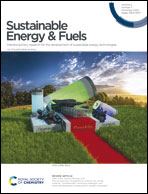Lithiated carbon cloth as a dendrite-free anode for high-performance lithium batteries†
Abstract
Infinite relative volume changes and uncontrolled dendrite growth have hindered the practical application of lithium metal anodes. Using stable host materials with prestored Li provides an ideal solution to this issue. In this work, we design a flexible lithiated carbon cloth (LCC) electrode by simply infusing molten Li into carbon cloth without lithiophilic modification. The LCC electrode exhibits a dendrite-free Li plating/stripping behavior and minor volume changes during cycling due to merits of evenly distributed Li nucleation sites, uniform local current density, and rich voids in the carbon cloth. The symmetric cells with LCC electrodes show superior cycling stability and lower voltage hysteresis, sustaining a high current density up to 5 mA cm−2 and an areal capacity as high as 5 mA h cm−2. The full battery performance of a LiFePO4 cell and Li–O2 cell with LCC anodes also shows a significant improvement compared to that with bare Li anodes. After 100 cycles, the LiFePO4 cell with the LCC anode shows 83.3% capacity retention while that with bare Li only shows 34.8% capacity retention, indicating promising applications of the LCC anode in next-generation Li metal batteries.



 Please wait while we load your content...
Please wait while we load your content...